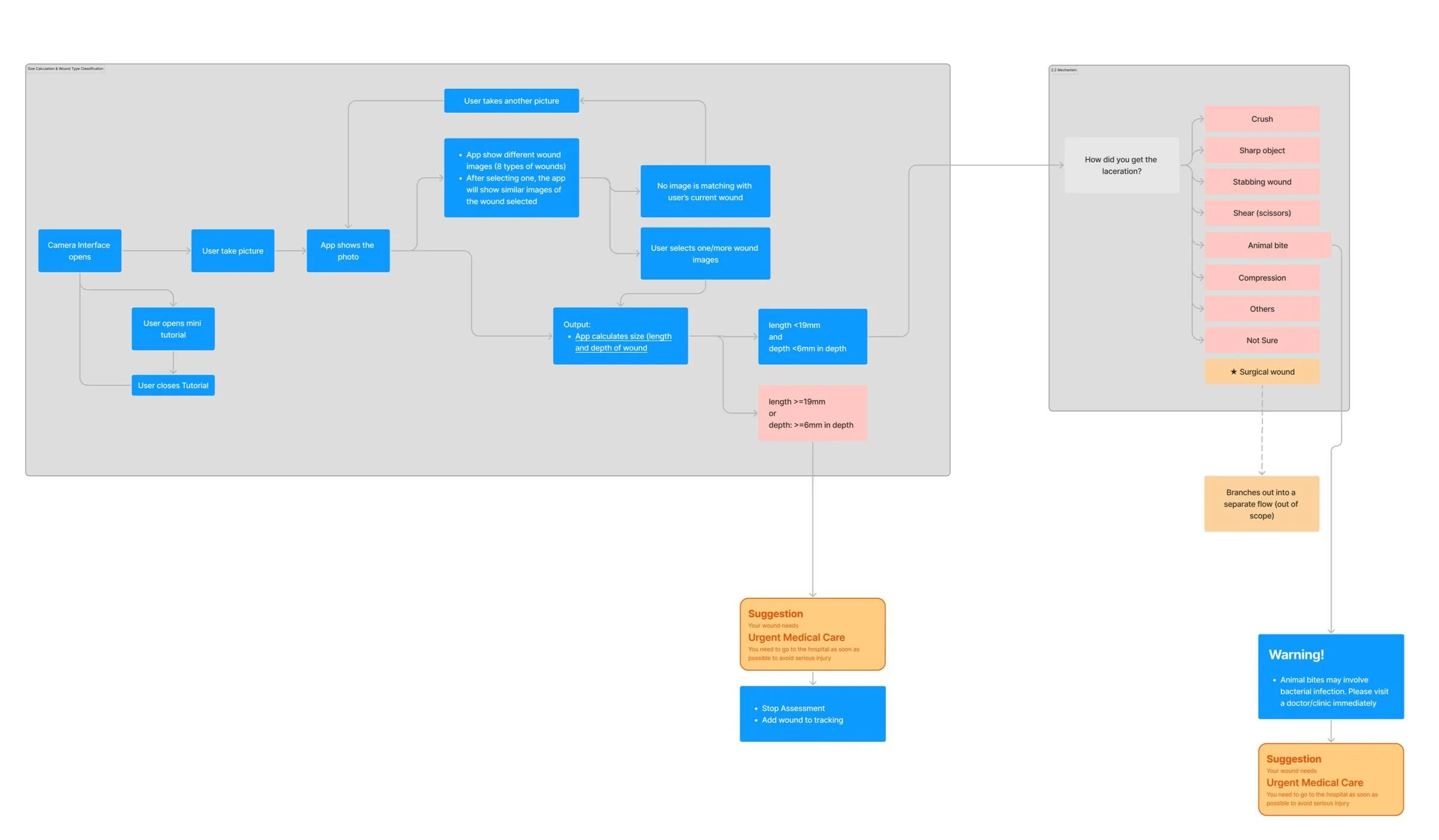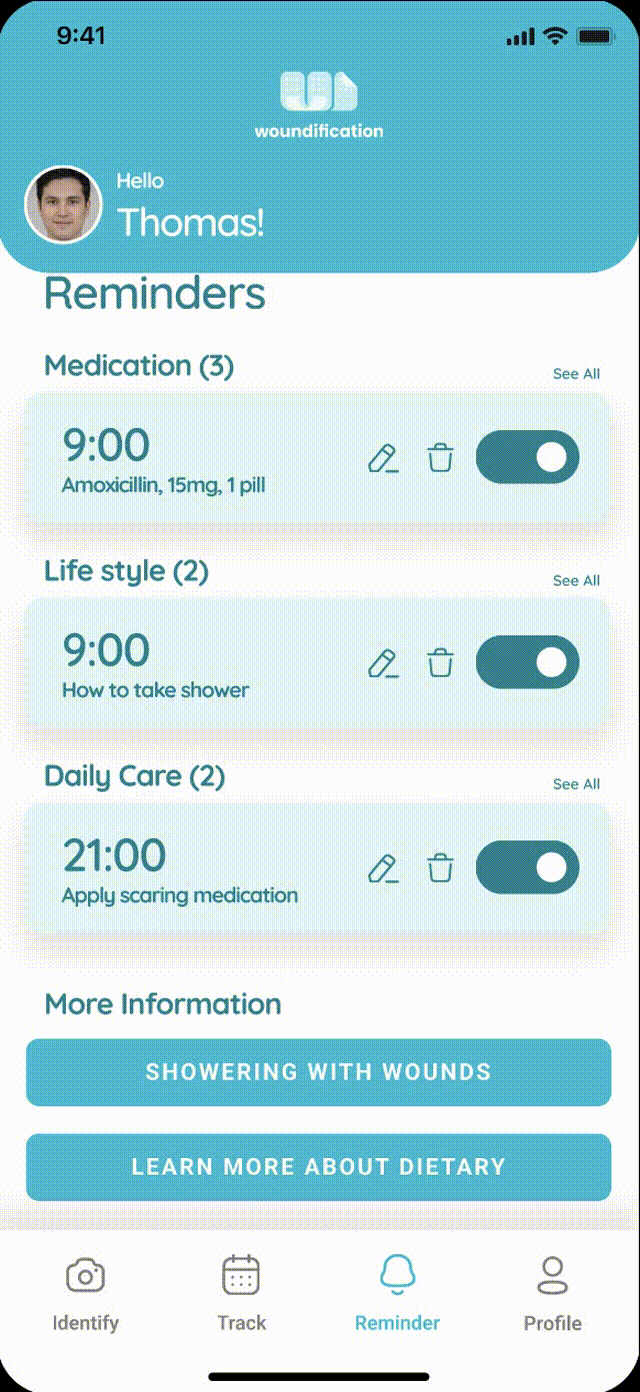Woundification
Application for personalized wound treatment suggestions
01 Overview
A mobile application that uses the device's camera to analyze wounds and provide personalized suggestions to treat them via non-medical suggestions, reminders, and wound tracking. The goal is to improve patients’ outcomes through precise assessment and effective wound care management.
As a UX Research Lead, I’m responsible for
Research Stage
Conducting primary and secondary research to dig out our target users’ pain points.
Doing a competitor analysis to carve design opportunities and craft product strategies.
Interviewing various user groups including medical practitioners, diabetic patients, and the public.
Design Stage
Creating information architecture and user workflows
Developing UI wireframes and interactive Figma prototypes.
Edited videos to be presented to stakeholders using Adobe Premiere Pro.
Role
UX Researcher
UI Designer
Methodology
Agile
Information Architecture
Design thinking
User Test
Client
Providence Health
Tools
Miro
Figma
photoshop
Adobe AE
Timeline
3 months
02 Problem Statement
How might we create a wound care service for users with chronic wounds to treat their wounds effectively and promptly?
Brushing up on wound-related medical concepts
While our team is tasked to design a wound care solution and I’m the assigned UX lead, I’m not yet an expert in the domain. So, in order to get a holistic understanding of wound care, I spent plenty of time diving into learning a range of fundamental wound knowledge, including the wound healing process, wound types, and the general wound assessment process.
Goals
Our project’s goal is divided into 2 parts:
Stakeholders' goal: to pitch an innovative solution with a proof-of-concept to investors and industry partners
Users’ goal: to provide a personalized and user-friendly wound care treatment suggestions
Key Findings
03 Discovery
Technical Research
Wound Classification with Machine Learning
Exploring research papers and articles that can aid wound classification with machine learning algorithms.
Wound Identification with OpenCV and HSV Color Scale Analysis
Exploring methods to identify whether an image is a wound through an algorithm that analyzes the colors of an image. This method converts an image from its original BGR (blue, green, red) color space to an HSV (hue, saturation, value) color space.
Color Patch Method for Automatically Calculating Wound sizes
Exploring research papers on to color patch method that scans images and calculates the wound size.
Wound Depth Perception
Exploring the Tensorflow, PyTorch, Keras, MXNet, and other libraries to implement wound depth perception technologies.
Based on the initial research, we identified eight distinct types of open wounds that our application can detect:
puncture wounds
burns caused by heat
chemicals
electricity
bites and stings
abrasions
cuts
bruises
blisters
ulcers
Technical Limitations
Camera Quality
A wide variety of smartphone cameras exist in today’s market making it difficult to have consistent photos for matching.Measurement Inconsistency
Without an easy-to-understand reference, the app/system may not measure the wounds properly.Skin Color Variation
in skin color may make it difficult for the app/system to recognize the state and type of wounds.Downloading Heavy App
Having a dedicated app on a mobile device may not be a feasible option for many users.Wound Image Database
Available and usable image databases of wounds may not be enough to create a good identifying solution.
Competitor Research
Identify market opportunities and competitors
Find the areas that we can offer and make improvement
Set realistic goals and benchmarks for our product
Key Findings
There is currently no existing application in the market for users with little medical knowledge to receive long-term personalized medical advice.
User Research
We had 3 iterations of the interviews. We initially focused on new wounds but following the first round of interviews, I noticed few individuals require guidance on wound care treatment for new wounds. Interestingly, a majority of people express the need for guidance when their old wounds fail to cure on time (or within their expected duration so-to-speak). This discovery led us to pivot our initial design accounting for old wounds.
Interview - Version 1 (First Iteration)
User Research Objectives
Before designing the user research, we listed out the questions that need to be clarified.
Do my users have impairments or disabilities to consider–whether temporary, situational, or permanent?
How familiar are my users with technology?
How are my users accessing the product or service?
Where and when are my users accessing the product or service?
Have I considered all my potential users?
To better understand the needs of users, we conducted a survey to figure out how people treat.
Demographic Information
Number of participants: 45
Gender: female (n=30 ); male (n=15)
Educational level: above high school
Age: 20-25 years old (n=25) ; above 25 years old (n=20)
Questions
What wounds are you most likely to have?
How it is usually treated?
How often do you pay attention to the changes in the wound?
Will you search online or download software?
Have you ever had severe trauma?
How did you treat it?
What are the general questions for wounds?
Do you carry coins with you?
How often do you bring a phone charger with you when you go out?
What is your phone model?
Conclusions
Measurement tool
Few people bring coins and chargers with them all the time
Suggested Features(user’s need for this app):
Compare to new wounds, they more care about the healing condition of old wounds or continuous follow-up
Medication instructions
Anticipated time or timeline
Prevent the wound
Get rid of the scar
Skin allergy (treatment)
How to go to the nearby available hospital that covered medical insurance fee
Some of them don’t want to take pictures, they prefer to select similar pictures and make comparisons by themselves
Most of them don’t need wound identification functions, because they know how causes of wounds
Want to know what kind of other symptoms will be infected
How to treat my wounds if I use the wrong way to treat them at the beginning
Want to know more about invisible diagnosis
Diabetics:
Have great demand for reminder functions—— their nerves are insensitive so that they will get hurt unconsciously
Want to know more about invisible diagnosis
Based on wounds, the app can provide more information about their condition
Long-term tracking function
Provide diabetics with educational resources on wound care, including information on how to prevent and manage wounds
Interview - Version 2 (Final Iteration)
Demographic Information
Number of participants: 45
Gender: Female (n=30); male (n=15)
Educational level: Above the high school
Age: Age: 20-25 years old (n=25); above 25 years old (n=20)
Assumptions
Users who have failed to treat the wounds by themselves, want to know why is their wound(s) not cured or getting better.
Users who have failed to treat the wounds by themselves, and want to know how to cure them.
Users who have scars and want to get rid of them.
Users who have a chronic wound(s) try to avoid infection and inflammation-diabetics, and users of old age.
Objectives
We aim to find out what common problems users have when they treat the wound(s) by themselves and what demands they need after treating wound(s) inappropriately.
Questions
How long does it take for a wound to heal?
When do you think you need to search the information about the wound or go to the hospital
If your wound doesn't heal on time, what would you do?
What support do you want to receive during your healing time?
What kind of questions do you always ask about your old wound (scar? inflammation?)
Where do you get the information on wound treatment?
How many problems do you think the suggestion part addressed?
Conclusions
Function:
It’s better to have the function of guidance of medication.
Details of why the system recommends this medicine to me.
I want to have a diverse combination of medications that I can choose.
I can’t find a big difference compared to Google research.
I want to have an online service, or simulated human service so as to enhance credibility. like you can list out the keywords I need to mention in the beginning, then I can type the content by myself. and the keywords will be extracted and analyzed by an AI system. So that many unnecessary steps can be omitted.
Typing long sentences is inconvenient, the voice input function is needed.
Experience
Poor experience. merely the standardized questions fail to convince me that the app truly takes all of my conditions into consideration. Diagnosis is not a standardized thing, the whole process overlooks too many personal conditions.
The result that the system gives is too general.
The way of information collection lack of credibility.
Your design should consider the psychological condition of patients.
Process
Lacking freedom: I have to follow the whole process and then get a result.
Several functions lack logic and connection.
Brainstorm
The interview results showed that people find it difficult to track their healing progress and search for personalized suggestions for their old wounds. Additionally, we found that diabetic patients commonly experience wound problems and have more complex conditions due to damage to nerves.
Based on these, we decided to look into implementations of the following features:
Wound identification and treatment suggestions for non-diabetic users.
Wound tracking and reminders for diabetic users.
Proposal
Identification
Provide wound identification function that helps patients know the type of wounds and their severity
Self-treatment suggestion
Provide tailored non-medical wound care suggestions that help the user handle old minor wounds appropriately and improve the user’s daily activities.
Medical reminder
Suggest nearby locations of clinics and hospitals especially if the wound becomes terrible or in other unpredictable conditions.
Wound tracking reminder
Assist in tracking users’ wound progress and remind them to address the old wound on a daily basis.
Woundication is an application
for people who are suffering from slow healing or chronic wounds
who would like to learn more about the condition of their wound and possible treatment options is an easy-to-use mobile application
which uses a series of assessment questions to understand the condition and classification of wounds
unlike Swift Skin and Wounds and Swift Ray 1 which are focused more on healthcare professionals
our product focuses on enabling everyday users to gain easy-to-understand medical knowledge about wound condition
04 Design Stage
Target Audience
• People who are suffering from chronic/slow healing wounds.
• People who experience minor/acute wounds on a day-to-day basis.
• Specific communities with special wound care needs.
User Flow
In order to provide accurate recommendations, I classified various factors that might be related to wound healing:
Different locations,
Types of laceration,
Level of laceration,
Different stages of laceration treatment,
General suggestions,
Cloth textures,
Activities,
Weather,
Prevention of scarring, and
Chronic disease
We are designing a wound identification system that collects wound information from users and provides non-diagnostic treatment suggestions accordingly. Part of the wound information will be collected by the phone camera, and the rest of the wound information will be collected through a questionnaire.
Wireframe + Mock up
Decision 1- Identification + Recommendation pages
We use camera recognition and questionnaires to identify wounds and provide personalized recommendations.
Wireframe
Final Iteration
Step 1: Wound Identification
Upon logging into the app, users select the wound location, take a picture, and submit it. After picture identification, users need to choose the reference pictures system provided to ensure accurate results.
Wireframe
Final Iteration
The system will ask for regular medical check-ups and generate the latest suggestions.
Step 2: Questionnaire
For accuracy and customized suggestions providing. Users are asked to answer the following questions related to their wounds and health condition.
Step 4: Tracking
Step 3: Recommendation
According to the result, nearby clinics, medications, and family doctor connections will be provided.
Decision 2- Tracking + Reminder function
We monitor the progress of wound healing and offer appropriate recommendations based on the users’ current state. At the same time, the notification function reminds them to take care of their wound in a timely manner.
Step 5: Notification
Notifications can be manually set to avoid inappropriate treatment that may result in poor healing, especially for older users.
















